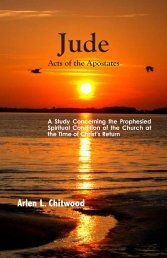Signs in John's Gospel - The Lamp Broadcast
Signs in John's Gospel - The Lamp Broadcast
Signs in John's Gospel - The Lamp Broadcast
Create successful ePaper yourself
Turn your PDF publications into a flip-book with our unique Google optimized e-Paper software.
Except a Man… (III) 103<br />
the salvation of their souls.<br />
An <strong>in</strong>dividual is saved with a purpose <strong>in</strong> view. And the whole<br />
of that purpose is seen <strong>in</strong> I Peter 1:3-9. This <strong>in</strong>itial Div<strong>in</strong>e work<br />
perta<strong>in</strong><strong>in</strong>g to salvation (hav<strong>in</strong>g to do with the salvation of the spirit)<br />
is with a view to a cont<strong>in</strong>ued Div<strong>in</strong>e work perta<strong>in</strong><strong>in</strong>g to salvation<br />
(the salvation of the soul), exactly as seen <strong>in</strong> and foreshadowed by<br />
God’s <strong>in</strong>itial restorative work occurr<strong>in</strong>g on the first day <strong>in</strong> Genesis<br />
chapter one; and His cont<strong>in</strong>ued restorative work, occurr<strong>in</strong>g dur<strong>in</strong>g<br />
time foreshadowed by Div<strong>in</strong>e activity dur<strong>in</strong>g the subsequent<br />
five days, is with a view to exactly the same th<strong>in</strong>g seen <strong>in</strong> the<br />
foundational type — a seventh day of rest.<br />
It is evident from both the text and context that the br<strong>in</strong>g<strong>in</strong>g<br />
forth from above <strong>in</strong> I Peter 1:3 would parallel the Div<strong>in</strong>e work seen<br />
<strong>in</strong> days two through six <strong>in</strong> Genesis chapter one, not the Div<strong>in</strong>e<br />
work seen on the first day. <strong>The</strong> br<strong>in</strong>g<strong>in</strong>g forth from above has to do<br />
with th<strong>in</strong>gs beyond the Spirit’s <strong>in</strong>itial work of salvation, through<br />
breath<strong>in</strong>g life <strong>in</strong>to the one hav<strong>in</strong>g no life. In the type <strong>in</strong> Ex. 12ff it<br />
would move to the po<strong>in</strong>t of resurrection (note text <strong>in</strong> I Peter), which<br />
would be typified by the Israelites on the eastern banks of the Red<br />
Sea <strong>in</strong> chapters fourteen and fifteen, with a hope, <strong>in</strong>heritance, and<br />
salvation set before them (ref. Chapter VIII <strong>in</strong> this book).<br />
<strong>The</strong> natural read<strong>in</strong>g and understand<strong>in</strong>g of the text, <strong>in</strong> the<br />
light of the context and Old Testament typology, would have to do<br />
with a Div<strong>in</strong>e work among Christians (a work among the saved,<br />
not the unsaved) relative to a present hope, which has to do with<br />
a future <strong>in</strong>heritance and salvation.<br />
This is “that blessed hope” <strong>in</strong> Titus 2:13, which, accord<strong>in</strong>g to<br />
the manner <strong>in</strong> which the Greek text is worded (ref. Chapter II <strong>in</strong><br />
this book), must be understood as “the appear<strong>in</strong>g of the glory of<br />
the great God, Who is our Saviour, Jesus Christ.”<br />
<strong>The</strong> purpose for a Div<strong>in</strong>e work cont<strong>in</strong>u<strong>in</strong>g <strong>in</strong> Christians,<br />
whether foreshadowed by the Old Testament types or seen <strong>in</strong><br />
verses such as I Peter 1:3-9, has to do with events of the seventh<br />
day, with the land (a heavenly land) set before them. This is<br />
what the epistles are about, which must be recognized if a proper<br />
and correct <strong>in</strong>terpretation and understand<strong>in</strong>g of the epistles is<br />
to be achieved.



